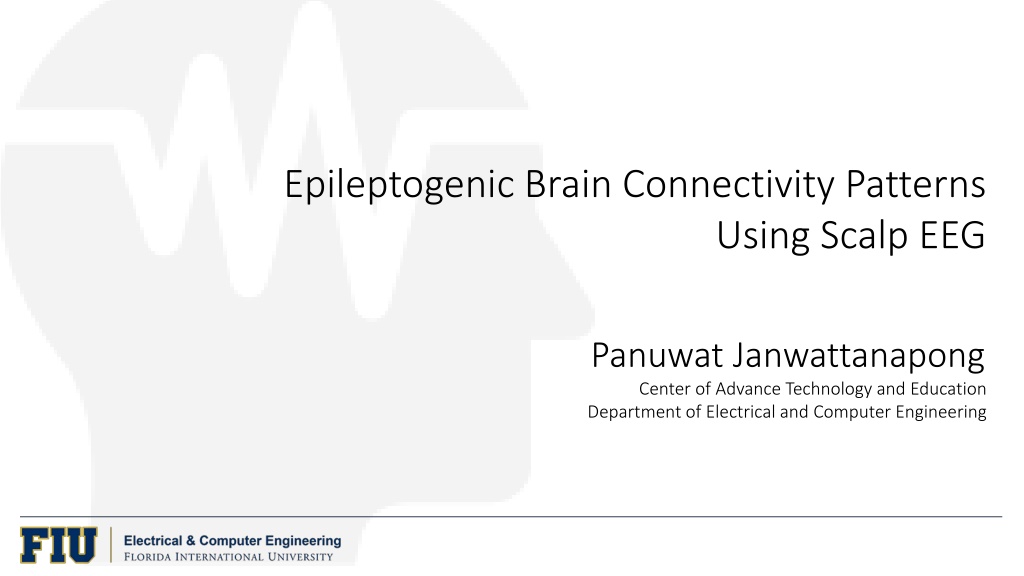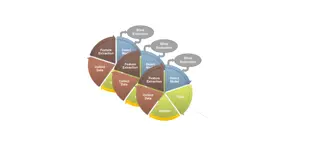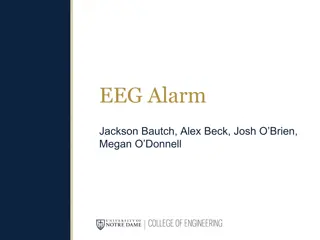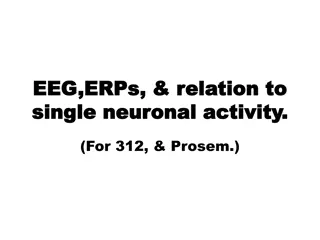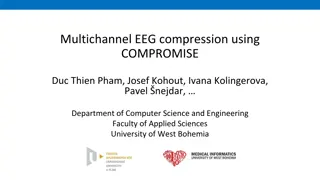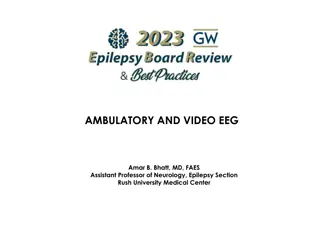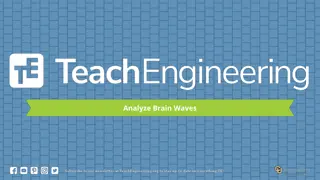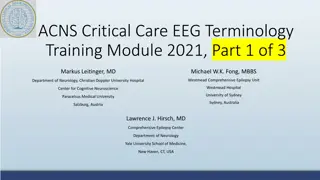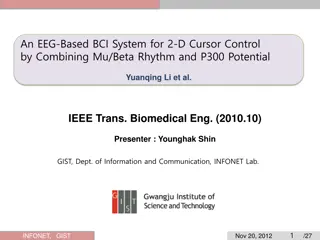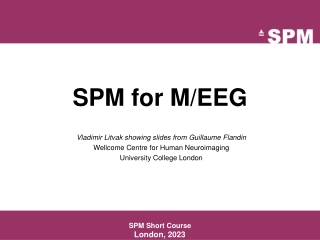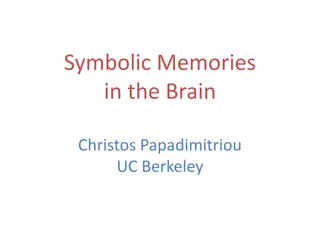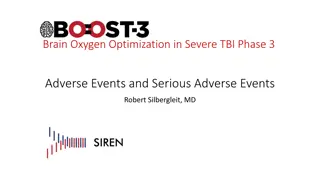Uncovering Epileptogenic Brain Connectivity Patterns Through Scalp EEG
Epilepsy is a common neurological disorder characterized by unprovoked seizures, affecting a significant portion of the population. Enhancing the diagnosis and prediction of seizures through EEG recordings can improve therapeutic strategies for epilepsy patients. Functional connectivity analysis in the cortex can reveal distinct patterns in different types of epileptiform discharges, aiding in classification parameters. This study aims to extract functional connectivity patterns from various types of epileptiform discharges and examine them in specific frequency bands to contribute to understanding epilepsy better.
Download Presentation

Please find below an Image/Link to download the presentation.
The content on the website is provided AS IS for your information and personal use only. It may not be sold, licensed, or shared on other websites without obtaining consent from the author. Download presentation by click this link. If you encounter any issues during the download, it is possible that the publisher has removed the file from their server.
E N D
Presentation Transcript
Epileptogenic Brain Connectivity Patterns Using Scalp EEG Panuwat Janwattanapong Center of Advance Technology and Education Department of Electrical and Computer Engineering
Introduction EPILEPSY EPILEPSY is a chronic disorder and is one of the most common neurological disorders affecting approximately 0.5 1 % of the entire population. The major characteristic which defines the disorder is the unprovoked seizures. Enhancing epilepsy diagnosis or even predict the occurrence of seizures through Electroencephalogram Electroencephalogram (EEG) recordings could lead to a better planning and therapeutic protocols. of epilepsy patient have had difficulty with a daily life activity due to epilepsy, including (EEG) recurrent 59% Driving 57% Working 52% Socializing Due to the unpredictable unpredictable occurrence of of seizures seizures, the quality of life of epileptic patients might be greatly impacted by this uncertainty. occurrence
Introduction FUNCTIONAL CONNECTIVITY FUNCTIONAL CONNECTIVITY is a study of neurological event occurring in the regions of the cortex. For analyzing the pattern of epileptiform discharges, functional connectivity would provide useful information where it is perceived that the characteristics of different types of epileptiform discharges will be distinct from each other creating a pattern that will be as classification parameters.
Objective FUNCTIONAL CONNECTIVITY FUNCTIONAL CONNECTIVITY is a study of neurological event occurring in the regions of the cortex. For analyzing the pattern of epileptiform discharges, functional connectivity would provide useful information where it is perceived that the characteristics of different types of epileptiform discharges will be distinct from each other creating a pattern that will be as classification parameters. o Study features of different epileptiform discharges namely, Interictal Spike, Spike and Slow Wave Complex, and Repetitive Spike and Slow Wave complex. o Extract functional connectivity patterns generated from each type of epileptiform discharges. o Patterns are examined in specific frequency bands, Delta band [0.1 - 4 Hz], Theta band [5 8 Hz], Alpha band [9 13 Hz], and Beta band [14 25 Hz].
Objective SSC RSS IS Repetitive Spike and Slow Wave complex Spike and Slow Wave Complex Epileptiform Discharges Epileptiform Discharges Interictal Spike
Algorithm EEG Data Segmentation Delta Band (0.1 ~ 4 Hz) Determine functional connectivity using cross-correlation Theta Band (5 ~ 8 Hz) Plot the functional connectivity maps based on the strength of the links Processing Average Montage Conversion and Baseline Removal Alpha Band (9 ~ 13 Hz) Count the number of connections the regions of interest Beta Band (14 ~ 25 Hz) Bandpass Filter Analyze statistically the functional connectivity pattern
Algorithm Functional Connectivity Extraction with Cross Correlation Analysis Functional Connectivity Extraction with Cross Correlation Analysis Cross-correlation coefficients between all pairwise montages of all 19 EEG channels were computed independently in the environment of MATLAB. IS IS SSC SSC RSS RSS The cross-correlation coefficient as measured between any two vectors x and y with length n, with a lag of m can be determined using the relation given in the equation.
Algorithm Functional Connectivity Extraction with Cross Correlation Analysis Functional Connectivity Extraction with Cross Correlation Analysis ? ? 1 ? 0 ??+??? ???? = ?=0 ??? ? ? < 0 Where x and y represent a vector of the EEG data of a pair of electrodes, with each containing 200 data points (n) assuming the 1s window of the EEG segments. The algorithm searches for the maximum cross-correlation coefficient over the lags (m) of 500ms and selects the maximum value in the range to be the strength of the functional connectivity representing each pair
Algorithm Quantification of Functional Connectivity Quantification of Functional Connectivity Anterior- Posterior Axis Left-Right Hemisphere
Results The connectivity results from the feature extraction are displayed for each frequency band. The head map average connectivity plots were obtained by taking an average of the connectivity matrices from the extracted 10 segments. The color in the maps indicate the strength of the connection, where dark connections and dark blue indicates weak connections. red indicates strong
Results Delta Band Delta Band Head map average connectivity plots for (a) interictal spike (b) spike with slow wave complex (c) repetitive spikes and slow wave complex
Results Delta Band Delta Band The ANOVA was calculated for each type of EDs with the null hypothesis that, the number of strong connections of the different ROIs is the same within each type of EDs. Head map average connectivity plots for For IS, the analysis is not significant (level of significant = 0.05, F (5, 54) = 0.4746, p-value = 0.7936). (a) interictal spike (b) spike with slow wave complex (c) repetitive spikes and slow wave complex The analysis for SSC and RSS are significant with F (5, 54) = 12.511, p-value = 0.00 and F (5, 54) = 2.8677, and p-value = 0.023 respectively
Results Theta Band Theta Band Head map average connectivity plots for (a) interictal spike (b) spike with slow wave complex (c) repetitive spikes and slow wave complex
Results Theta Band Theta Band The ANOVA was calculated for each type of EDs with the null hypothesis that, the number of strong connections of the different ROIs is the same within each type of EDs. Head map average connectivity plots for For IS, the analysis was not significant at the level of significant = 0.05, F (5, 54) = 1.2764, p-value = 0.2876. (a) interictal spike (b) spike with slow wave complex (c) repetitive spikes and slow wave complex Where the analysis for SSC and RSS were significant, F (5, 54) = 2.4218, p-value = 0.047 and F (5, 54) = 3.4375, p-value = 0.01 respectively
Results Alpha Band Alpha Band Head map average connectivity plots for (a) interictal spike (b) spike with slow wave complex (c) repetitive spikes and slow wave complex
Results Alpha Band Alpha Band ANOVA indicated that the strongest connections for each type of ED in different ROIs for these bands are not statistically different. Thus the null hypothesis is not rejected Head map average connectivity plots for the analysis where the connections were categorized into each type of ED showed that the analysis was significant with F (2, 177) = 49.84, p-value = 0.00 ) (a) interictal spike (b) spike with slow wave complex (c) repetitive spikes and slow wave complex
Results Beta Band Beta Band Head map average connectivity plots for (a) interictal spike (b) spike with slow wave complex (c) repetitive spikes and slow wave complex
Results Beta Band Beta Band ANOVA indicated that the strongest connections for each type of ED in different ROIs for these bands were not statistically different. Thus the null hypothesis was not rejected Head map average connectivity plots for the analysis where the connections were categorized into each type of ED showed that the analysis was significant with F (2, 177) = 40.28, p- value = 0.00 (a) interictal spike (b) spike with slow wave complex (c) repetitive spikes and slow wave complex
Conclusion The quantification and extraction of functional connectivity patterns using scalp EEG can generate important features that can be used to classify the type of epilepsy. The patterns extracted by performing coherence analysis revealed different characteristics of each type of Epileptic Discharges (EDs) exhibited in different frequency bands. The outcome of the connectivity analysis by using cross-correlation has to be interpreted with care. This method does not provide causality assessment, where the flow of information cannot be determined. The aforementioned case leads to the limitation of the interpretation of the results
References Fisher, R. S., Boas, W. V. E., Blume, W., Elger, C., Genton, P., Lee, P., & Engel, J. (2005). Epileptic seizures and epilepsy: definitions proposed by the International League Against Epilepsy (ILAE) and the International Bureau for Epilepsy (IBE). Epilepsia, 46(4), 470-472. van Mierlo, P., Papadopoulou, M., Carrette, E., Boon, P., Vandenberghe, S., Vonck, K., & Marinazzo, D. (2014). Functional brain connectivity from EEG in epilepsy: Seizure prediction and epileptogenic focus localization. Progress in neurobiology, 121, 19-35. Brodie, M. J., & Kwan, P. (2002). Staged approach to epilepsy management. Neurology, 58(8 suppl 5), S2-S8.B. S. Sargolzaei , M. Cabrerizo, M. Goryawala, A. Salah Eddin, Scalp EEG Brain Functional Connectivity Networks in Pediatric Epilepsy , Computers in Biology and Medicine, Vol. 56 pp. 158-166, Jan. 2015. S. Sargolzaei, M. Cabrerizo, A. Sargolzaei, S. Noei, H. Rajaei, A. Salah Eddin, A. Pinzon-Ardila, S. M. Gonzalez Arias, P. Jayakar and M. Adjouadi, A probabilistic approach for pediatric epilepsy diagnosis using brain functional connectivity networks, BMC Bioinformatics, Vol. 16, Suppl. 7, April 2015 Salah Eddin, J. Wang, W. Wu, S. Sargolzaei, B. Bjornson, R. Jones, W.D. Gaillard, and M. Adjouadi, The Effects of Pediatric Epilepsy on a Language Connectome , Human Brain Mapping, Vol. 35 (12), pp. 5996 6010, December 2014 Delorme, A., & Makeig, S. (2004). EEGLAB: an open source toolbox for analysis of single-trial EEG dynamics including independent component analysis. Journal of neuroscience methods, 134(1), 9-21. Shafi, M. M., Westover, M. B., Oberman, L., Cash, S. S., & Pascual-Leone, A. (2014). Modulation of EEG functional connectivity networks in subjects undergoing repetitive transcranial magnetic stimulation. Brain topography, 27(1), 172-191. Dodel, S., Herrmann, J. M., & Geisel, T. (2002). Functional connectivity by cross-correlation clustering. Neurocomputing, 44, 1065-1070. Siggiridou, E., Kugiumtzis, D. and Kimiskidis, V.K., 2014. Correlation networks for identifying changes in brain connectivity during epileptiform discharges and transcranial magnetic stimulation. Sensors, 14(7), pp.12585-12597. Cascino, G. D. (2004). Surgical treatment for epilepsy. Epilepsy research,60(2), 179-186 Wendling, F., Ansari-Asl, K., Bartolomei, F., & Senhadji, L. (2009). From EEG signals to brain connectivity: a model-based evaluation of interdependence measures. Journal of neuroscience methods, 183(1), 9-18. Friston, K. J. (1994). Functional and effective connectivity in neuroimaging: a synthesis. Human brain mapping, 2(1 2), 56-78. Waites, A. B., Briellmann, R. S., Saling, M. M., Abbott, D. F., & Jackson, G. D. (2006). Functional connectivity networks are disrupted in left temporal lobe epilepsy. Annals of neurology, 59(2), 335-343. Stam, C. J., Nolte, G., & Daffertshofer, A. (2007). Phase lag index: assessment of functional connectivity from multi-channel EEG and MEG with diminished bias from common sources. Human brain mapping, 28(11), 1178-1193. 1. 2. 3. 4. 5. 6. 7. 8. 9. 10. 11. 12. 13. 14. 15.
Thank you Q&A
